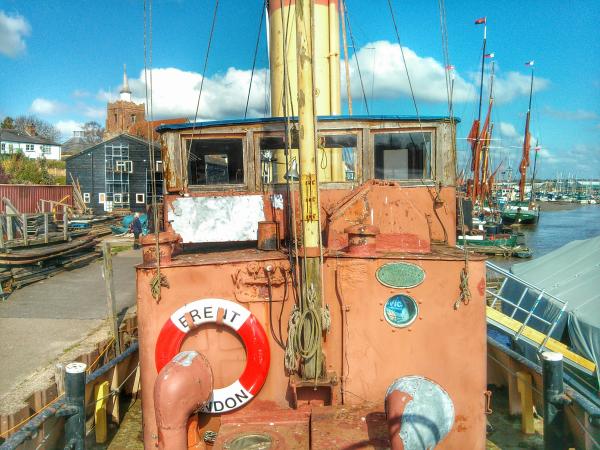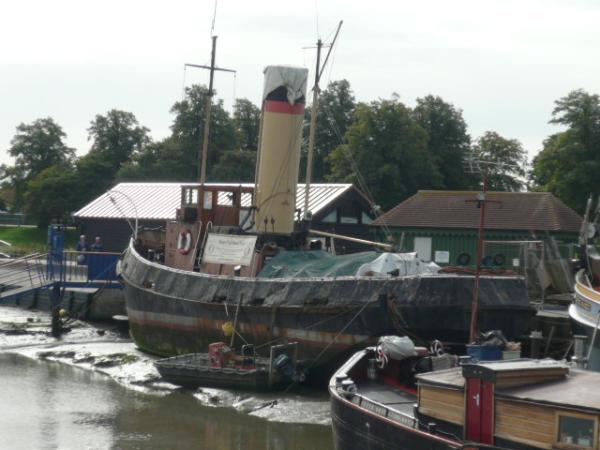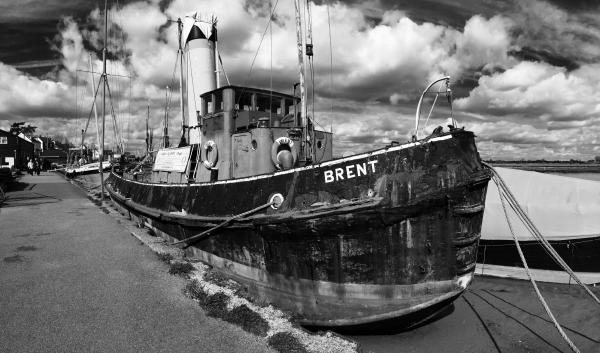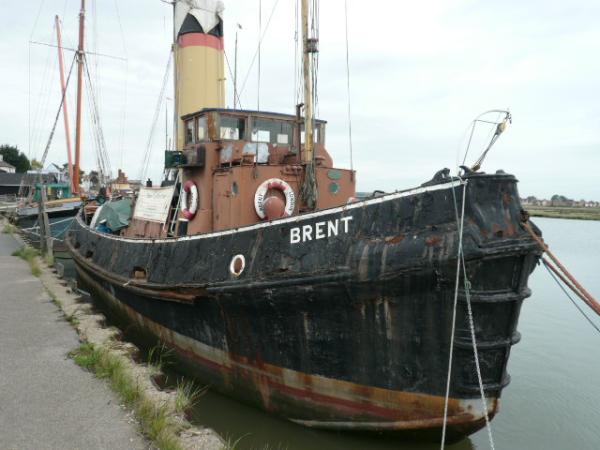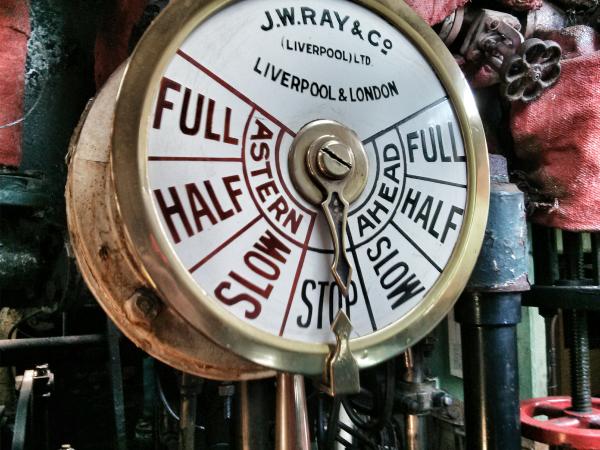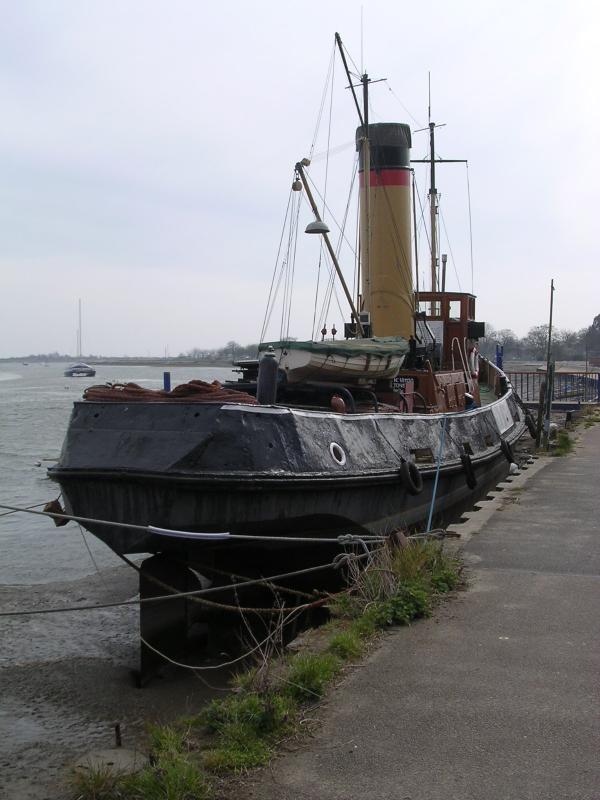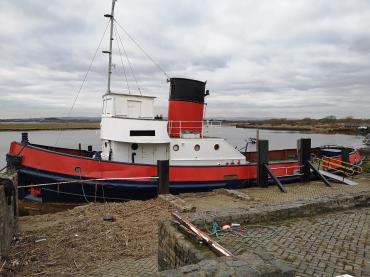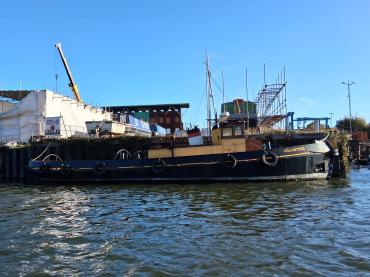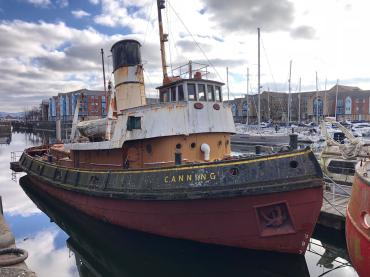


Previous names
- 1945 - 1946 TID 159
Details
Construction
Dimensions
History
Built in 1945 by William Pickersgill, Sunderland for the Ministry of War Transport and designated TID 159, BRENT was one of 182 TID class tugs built between 1943 and 1946. These steam tugs were one of the first UK ventures into all welded prefabricated steel shipbuilding. Most were used by the Admiralty. TID 159 was one of the last to be built and did not see war service.
She was sold to the Port of London Authority at a subsidised price to replace wartime losses and renamed BRENT. Working in the Dredging Department and Dock System of the PLA she was eventually laid up in 1969 and sold to a shipbreaker in 1970.
BRENT was saved for preservation by Ron and Janet Hall in 1971. She was successfully used as a floating home and tug yacht, with minimal alteration to her original fabric, but some changes made to allow for living on board. The engine room and machinery are still entirely as original. For some 25 years she sailed round Thames and East Coast waters and twice went as far as the Netherlands. Due to concerns about her boiler, she was laid up in 1994. In 2002 her bottom was over plated to prevent water ingress and part of the hull was re-plated. She was moved to her current berth at Cook’s Yard, Maldon, by the promenade path.
A trust was set up for her preservation and in 2011 she was placed under the ownership of the Steam Tug Brent Trust. For maintenance and restoration, a small team of volunteers work on board regularly. The Trustees are seeking funding for major repairs, to enable her to steam again.
Significance
1. What is the vessel’s ability to demonstrate history in her physical fabric? Evidence for designs, functions, techniques, processes, styles, customs and habits or uses and associations in relation to events and people. How early, intact or rare these features are may impact on significance.
Steam tug BRENT was one of the UK’s first ventures into all welded, prefabricated steel shipbuilding. Her flat bottomed hull is of a flat plate, “hard chine” construction having three simple elements to make up a very basic hull form – a horizontal, 45 degree and vertical shell plates with a small curved section over the propeller and under the counter. To provide ease of construction, rigidity, and prevention of movement, the frames were very closely spaced and numerous for the time. The fabric of her hull, superstructure, wheelhouse, funnel, foremast and deck fittings are unchanged from her build date, as is her engine room and machinery. Additions were made to her when she was purchased by the Port of London Authority including strengthening her decks and bow section and re-siting her aft bollards and forward Samson post. At some stage the air vents by the funnel were removed. At a later date with the PLA, they removed her windlass as it was not needed for her work in London’s enclosed dock system. Under private preservation, she has a TID tug windlass fitted in 1973. Her accommodation was fitted out for her use as a houseboat in 1971 though no changes are irreversible and where possible all original features have been retained, such as the original bench seating in the aft cabin which is in its original state as can be seen from the shipyard drawings and her original galley stove which is due to be reinstalled. Most concessions to living aboard were made in the fo’c’sle, where part of the conversion will be left as evidence of this time in Brent’s history. Her bulwarks and superstructure have knocks and dents that are evidence of her working life as a small tug in a busy port.
2. What are the vessel’s associational links for which there is no physical evidence? Associations with people or places. Off-ship research.
Steam tug BRENT was one of the 182 “TID” vessels commissioned by the British Admiralty. Built by William Pickersgill & Sons of Southwark Sunderland in 1945 Steam Tug BRENT, then known as TID 159, was one of the last of the class to be constructed and she missed out being used by the Admiralty War Service. She has strong associations with the Port of London Authority, having being sold to them after the war and put to use working for the River Dredging Department on the Thames. She later worked tending barges and lighters within the extensive dock system. With the demise of general trade and shipping, combined with the move to containerisation at Tilbury, most steam tugs became obsolete and were scrapped, leaving BRENT the very last steam vessel in service with the PLA until she was sold for scrap in 1970. In 1953, being one of the newest craft in the PLA’s fleet, she pulled the firework barges for the Queen’s Coronation celebrations on the Thames. She is well documented with a substantial archive of her plans and photographs of her throughout her working life, as well as her life from the early 1970’s in private ownership where she attended numerous boat rallies and festival. Major events include winning the Greenwich Festival “Best Kept Privately Owned Power Craft” award in 1973; escorting fishing smacks carrying Oysters on a race from Gravesend to Billingsgate in 1976; attending the Queen’s Jubilee celebrations on the Thames in 1977; and completing two successful voyages to the Netherlands. BRENT was recorded on the National Register of Historic Vessels in 2010. Brent has a substantial and growing archive collection. Links have been made with past PLA crew members. Ongoing research includes the TID tugs’ wartime service and the Normandy landings
3. How does the vessel’s shape or form combine and contribute to her function? Overall aesthetic impact of the vessel, her lines, material she was built from and her setting. Does she remain in her working environment?
BRENT was built to a specification which allowed for quick construction during war time - at its peak, a “TID” was being built and launched within four and a half days. To save time during construction, TID tugs were built of modular and welded prefabricated units, each of which could be made at inland non-marine fabrication facilities, with most of the assembly work being carried out by women. Her robust construction and the preservation policies which have been in place since she was a working vessel, mean that she has survived intact, with only superficial alterations, which can be reversed, made to her superstructure, and some overplating to her hull. Despite her workmanlike aesthetic she is pleasing to the eye, well maintained under private ownership and a reminder of a turning point in ship construction.
Key dates
-
2011
The vessel is now owned by the Steam Tug Brent Trust and is no longer in private owsnership Source: current owners
-
1945
Built for the MoWT as TID 159
-
1946
Acquired and fitted out by the PLA, renamed "Brent"
-
1970
Sold to Stour Salvage for breaking
-
1971
Bought by Ron and Janet Hall for preservation
-
2011
Acquired by Steam Tug Brent Trust
Grants
-
May 2024
The National Lottery Heritage Fund has made them a grant award of £97,488.00 towrds her restoration
Sources
Ron L Hall, Ships Monthly (January Still in Steam, 1977) Still in Steam: Steam Tug Brent
Norman J Brouwer, International Register of Historic Ships (Edition 2, 1993, pp137-8) pub: Anthony Nelson
Steamboat Register: An illustrated Register of surviving steam vessels in the British Isles (May Edition 6, 1994) pub: Steam Boat Association of Great Britain
Ron L Hall, Ships Monthly (May, 1972, pp182-3) I fell in love with a steam tug
M J Gaston, Warship World (Spring, 1986, pp20-21) TIDs were a Temporary Measure
Ron L Hall, Steam Tug 'Brent' - leaflet pub: Hall, Ron L
Own this vessel?
If you are the owner of this vessel and would like to provide more details or updated information, please contact info@nationalhistoricships.org.uk


